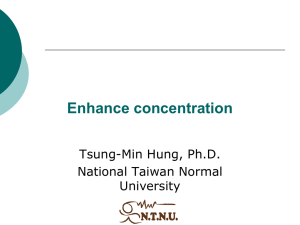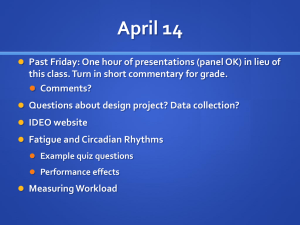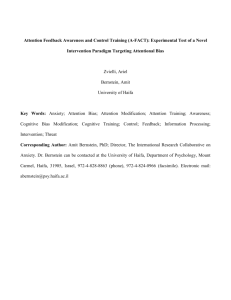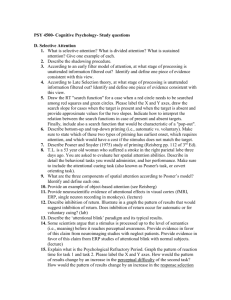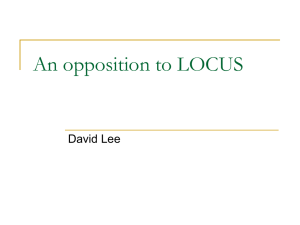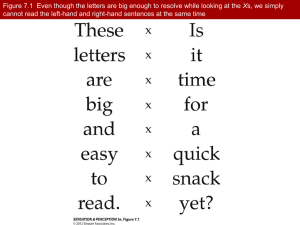Neural Models for Part-Whole Hierarchies
advertisement
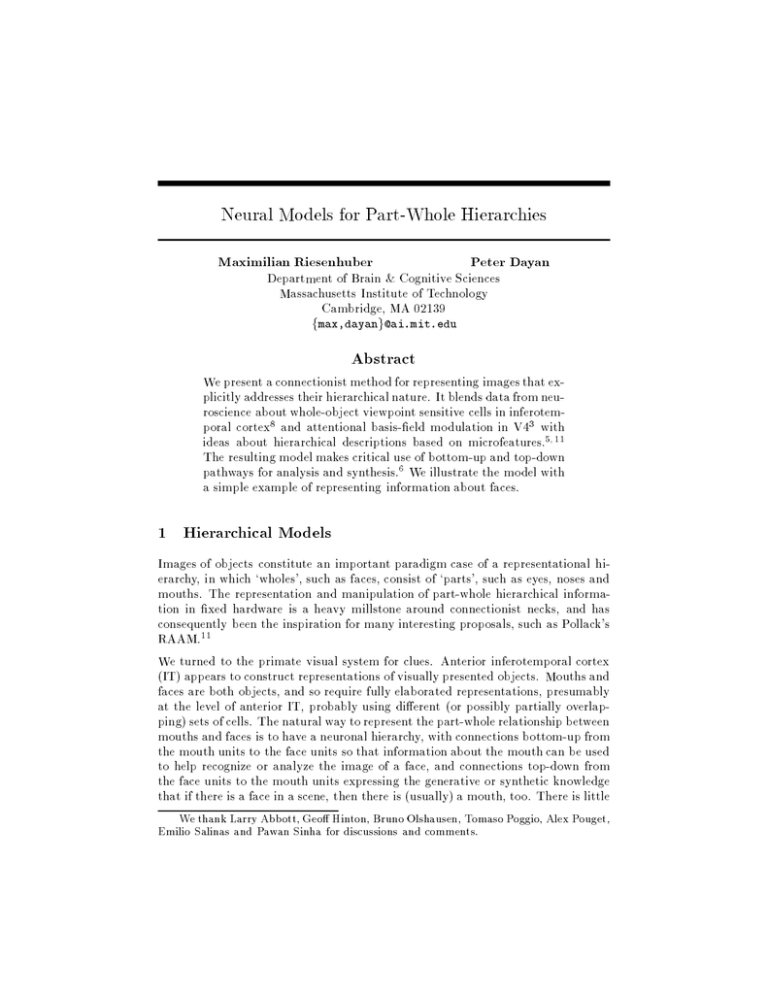
Neural Models for Part-Whole Hierarchies
Maximilian Riesenhuber
Peter Dayan
Department of Brain & Cognitive Sciences
Massachusetts Institute of Technology
Cambridge, MA 02139
fmax,dayang@ai.mit.edu
Abstract
We present a connectionist method for representing images that explicitly addresses their hierarchical nature. It blends data from neuroscience about whole-object viewpoint sensitive cells in inferotemporal cortex and attentional basis-eld modulation in V4 with
ideas about hierarchical descriptions based on microfeatures.
The resulting model makes critical use of bottom-up and top-down
pathways for analysis and synthesis. We illustrate the model with
a simple example of representing information about faces.
8
3
5, 11
6
1 Hierarchical Models
Images of objects constitute an important paradigm case of a representational hierarchy, in which `wholes', such as faces, consist of `parts', such as eyes, noses and
mouths. The representation and manipulation of part-whole hierarchical information in xed hardware is a heavy millstone around connectionist necks, and has
consequently been the inspiration for many interesting proposals, such as Pollack's
RAAM.
We turned to the primate visual system for clues. Anterior inferotemporal cortex
(IT) appears to construct representations of visually presented objects. Mouths and
faces are both objects, and so require fully elaborated representations, presumably
at the level of anterior IT, probably using dierent (or possibly partially overlapping) sets of cells. The natural way to represent the part-whole relationship between
mouths and faces is to have a neuronal hierarchy, with connections bottom-up from
the mouth units to the face units so that information about the mouth can be used
to help recognize or analyze the image of a face, and connections top-down from
the face units to the mouth units expressing the generative or synthetic knowledge
that if there is a face in a scene, then there is (usually) a mouth, too. There is little
11
We thank Larry Abbott, Geo Hinton, Bruno Olshausen, Tomaso Poggio, Alex Pouget,
Emilio Salinas and Pawan Sinha for discussions and comments.
empirical support for or against such a neuronal hierarchy, but it seems extremely
unlikely on the grounds that arranging for one with the correct set of levels for all
classes of objects seems to be impossible.
There is recent evidence that activities of cells in intermediate areas in the visual
processing hierarchy (such as V4) are inuenced by the locus of visual attention.
This suggests an alternative strategy for representing part-whole information, in
which there is an interaction, subject to attentional control, between top-down
generative and bottom-up recognition processing. In one version of our example,
activating units in IT that represent a particular face leads, through the top-down
generative model, to a pattern of activity in lower areas that is closely related to
the pattern of activity that would be seen when the entire face is viewed. This
activation in the lower areas in turn provides bottom-up input to the recognition
system. In the bottom-up direction, the attentional signal controls which aspects of
that activation are actually processed, for example, specifying that only the activity
reecting the lower part of the face should be recognized. In this case, the mouth
units in IT can then recognize this restricted pattern of activity as being a particular
sort of mouth. Therefore, we have provided a way by which the visual system can
represent the part-whole relationship between faces and mouths.
This describes just one of many possibilities. For instance, attentional control could
be mainly active during the top-down phase instead. Then it would create in V1 (or
indeed in intermediate areas) just the activity corresponding to the lower portion
of the face in the rst place. Also the focus of attention need not be so ineluctably
spatial.
The overall scheme is based on an hierarchical top-down synthesis and bottom-up
analysis model for visual processing, as in the Helmholtz machine (note that \hierarchy" here refers to a processing hierarchy rather than the part-whole hierarchy
discussed above) with a synthetic model forming the eective map:
`object' `attentional eye-position' ! `image'
(1)
(shown in cartoon form in gure 1) where `image' stands in for the (probabilities
over the) activities of units at various levels in the system that would be caused by
seeing the aspect of the `object' selected by placing the focus and scale of attention
appropriately. We use this generative model during synthesis in the way described
above to traverse the hierarchical description of any particular image. We use the
statistical inverse of the synthetic model as the way of analyzing images to determine
what objects they depict. This inversion process is clearly also sensitive to the
attentional eye-position { it actually determines not only the nature of the object
in the scene, but also the way that it is depicted (i.e., its instantiation parameters)
as reected in the attentional eye position.
In particular, the bottom-up analysis model exists in the connections leading to
the 2D viewpoint-selective image cells in IT reported by Logothetis et al. which
form population codes for all the represented images (mouths, noses, etc.). The
top-down synthesis model exists in the connections leading in the reverse direction.
In generalizations of our scheme, it may, of course, not be necessary to generate an
image all the way down in V1.
The map (1) species a top-down computational task very like the bottom-up one
addressed using a multiplicatively controlled synaptic matrix in the shifter model
3
6
8
layer
3
o
V
2
r
V
attentional
eye
position e =(ex, ey, ez )
g
m
Wr
Wg
5
10
1
p
15
20
25
30
5
10
15
20
25
30
Figure 1: Cartoon of the model. In the top-down, generative, direction, the model generates
images of faces, eyes, mouths or noses based on an attentional eye position and a selection of a
single top-layer unit; the bottom-up, recognition, direction is the inverse of this map. The response
of the neurons in the middle layer is modulated sigmoidally (as illustrated by the graphs shown
inside the circles representing the neurons in the middle layer) by the attentional eye position. See
section 2 for more details.
of Olshausen et al . Our solution emerges from the control the attentional eye
position exerts at various levels of processing, most relevantly modulating activity
in V4. Equivalent modulation in the parietal cortex based on actual (rather than
attentional) eye position has been characterized by Pouget & Sejnowski and
Salinas & Abbott in terms of basis elds. They showed that these basis elds
can be used to solve the same tasks as the shifter model but with neuronal rather
than synaptic multiplicative modulation. In fact, eye-position modulation almost
certainly occurs at many levels in the system, possibly including V1. Our scheme
clearly requires that the modulating attentional eye-position must be able to become
detached from the spatial eye-position { Connor et al. collected evidence for part of
this hypothesis; although the coordinate system(s) of the modulation is not entirely
clear from their data.
Bottom-up and top-down mappings are learned taking the eye-position modulation into account. In the experiments below, we used a version of the wake-sleep
algorithm, for its conceptual and computational simplicity. This requires learning
the bottom-up model from generated imagery (during sleep) and learning the topdown model from assigned explanations (during observation of real input during
wake). In the current version, for simplicity, the eye position is set correctly during
recognition, but we are also interested in exploring automatic ways of doing this.
9
3
1
13
15
12
3
6
2 Results
We have developed a simple model that illustrates the feasibility of the scheme
presented above in the context of recognizing and generating cartoon drawings of
a face and its parts. Recognition involves taking an image of a face or a part
thereof (the mouth, nose or one of the eyes) at an arbitrary position on the retina,
a)
b)
0.8
0.8
0.6
0.6
0.4
0.4
face
nose
mouth
eye
0.2
0.2
0
face
0
mouth nose
eye
face
mouth nose
eye
mouth nose
eye
0.8
0.8
0.6
0.6
0.4
0.4
0.2
0.2
0
0
−0.2
face
mouth nose
eye
face
Figure 2: a) Recognition: the left column of each pair shows the stimuli; the right shows the
resulting activations in the top layer (ordered as face, mouth, nose and eye). The stimuli are faces
at random positions in the retina. Recognition is performed by setting the attentional eye position
in the image and setting the attentional scale, which creates a window of attention around the
attended to position, shown by a circle of corresponding size and position. b) Generation: each
panel shows the output of the generative pathway for a randomly chosen attentional eye position
on activating each of the top layer units in turn. The focus of attention is marked by a circle
whose size reects the attentional scale. The name of the object whose neuronal representation in
the top layer was activated is shown above each panel.
and setting the appropriate top level unit to 1 (and the remaining units to zero).
Generation involves imaging either a whole face or of one of its parts (selected by
the active unit in the top layer) at an arbitrary position on the retina.
The model (gure 1) consists of three layers. The lowest layer is a 32 32 `retina'.
In the recognition direction, the retina feeds into a layer of 500 hidden units. These
project to the top layer, which has four neurons. In the generative direction, the
connectivity is reversed. The network is fully connected in both directions. The
activity of each neuron based on input from the preceding (for recognition) or the
following layer (for generation) is a linear function (weight matrices W ; V in the
recognition and V ; W in the generative direction). The attentional eye position
inuences activity through multiplicative modulation of the neuronal responses in
the hidden layer. The linear response r = (W p) or r = (V o) of each neuron i
in the middle layer based on the bottom-up or top-down connections is multiplied
by = (e ) (e ) (e ), where f g are the tuning curves in each dimension
of the attentional eye position e = (e ; e ; e ), coding the x- and y- coordinates and
the scale of the focus of attention, respectively. Thus, for the activity m of hidden
neuron i we have m = (W p) in the recognition pathway and m = (V o) in
the generative pathway. The tuning curves of the are chosen to be sigmoid with
random centers c and random directions d 2 f;1; 1g, e.g., = (4 d (e ; c )).
In other implementations, we have also used Gaussian tuning functions. In fact,
the only requirement regarding the shape of the tuning functions is that through a
superposition of them one can construct functions that show a peaked dependence
on the attentional eye position. In the recognition direction, the attentional eye
position also has an inuence on the activity in the input layer by dening a `window
of attention', which we implemented using a Gaussian window centered at the
attentional eye position with its size given by the attentional scale. This is to allow
the system to learn models of parts based on experience with images of whole faces.
To train the model, we employ a variant of the unsupervised wake-sleep algorithm.
In this algorithm, the generative pathway is trained during a wake-phase, in which
r
g
r
i
i
x
i
x
y
i
y
r
g
s
i
i
g
i
i
x;y;s
s
i
x
y
s
i
i
r
i
i
g
i
i
i
i
i
i
s
i
s
i
s
s
i
7
6
stimuli in the input layer (the retina, in our case) cause activation of the neurons
in the network through the recognition pathway, providing an error signal to train
the generative pathway using the delta rule. Conversely, in the sleep-phase, random
activation of a top layer unit (in conjunction with a randomly chosen attentional
eye-position) leads, via the generative connections, to the generation of activation
in the middle layer and consequently an image in the input layer that is then used to
adapt the recognition weights, again using the delta rule. Although the delta rule in
wake-sleep is ne for the recognition direction, it leads to a poor generative model
{ in our simple case, generation is much more dicult than recognition. As an
interim solution, we therefore train the generative weights using back-propagation,
which uses the activity in the top layer created by the recognition pathway as the
input and the retinal activation pattern as the target signal. Hence, learning is
still unsupervised (except that appropriate attentional eye-positions are always set
during recognition). We have also experimented with a system in which the weights
W and W are preset and only the weights between layers 2 and 3 are trained.
For this model, training could be done with the standard wake-sleep algorithm, i.e.,
using the local delta-rule for both sets of weights.
Figure 2a shows several examples of the performance of the recognition pathway for
the dierent stimuli after 300,000 iterations. The network is able to recognize the
stimuli accurately at dierent positions in the visual eld. Figure 2b shows several
examples of the output of the generative model, illustrating its capacity to produce
images of faces or their parts at arbitrary locations. By imaging a whole face and
then focusing the attention on e.g., an area around its center, which activates the
`nose' unit through the recognition pathway, the relationship that, e.g., a nose is
part of a face can be established in a straightforward way.
r
g
3 Discussion
Representing hierarchical structure is a key problem for connectionism. Visual
images oer a canonical example for which it seems possible to elucidate some of
the underlying neural mechanisms. The theory is based on 2D view object selective
cells in anterior IT, and attentional eye-position modulation of the ring of cells in
V4. These work in the context of analysis by synthesis or recognition and generative
models such that the part-whole hierarchy of an object such as a face (which contains
eyes, which contain pupils, etc.) can be traversed in the generative direction by
choosing to view the object through a dierent eective eye-position, and in the
recognition direction by allowing the real and the attentional eye-positions to be
decoupled to activate the requisite 2D view selective cells.
The scheme is related to Pollack's Recursive Auto-Associative Memory (RAAM)
system. RAAM provides a way of representing tree-structured information { for
instance to learn an object whose structure is ffA; B g; fC; Dgg, a standard threelayer auto-associative net would be taught AB, leading to a pattern of hidden unit
activations ; then it would learn CD leading to ; and nally leading to ,
which would itself be the representation of the whole object. The compression
operation (AB ! ) and its expansion inverse are required as explicit methods for
manipulating tree structure.
Our scheme for representing hierarchical information is similar to RAAM, using
the notion of an attentional eye-position to perform its compression and expansion
11
operations. However, whereas RAAM normally constructs its own codes for intermediate levels of the trees that it is fed, here, images of faces are as real and as
available as those, for instance, of their associated mouths. This not only changes
the learning task, but also renders sensible a notion of direct recognition without
repeated RAAMication of the parts.
Various aspects of our scheme require comment: the way that eye position aects
recognition; the coding of dierent instances of objects; the use of top-down information during bottom-up recognition; variants of the scheme for objects that are
too big or too geometrically challenging to `t' in one go into a single image; and
hierarchical objects other than images. We are also working on a more probabilistically correct version, taking advantage of the statistical soundness of the Helmholtz
machine.
Eye position information is ubiquitous in visual processing areas, including the
LGN and V1, as well as the parietal cortex and V4. Further, it can be revealed
as having a dramatic eect on perception, as in Ramachandran et al.'s study on
intermittent exotropes. This is a form of squint in which the two eyes are normally
aligned, but in which the exotropic eye can deviate (voluntarily or involuntarily) by
as much as 60. The study showed that even if an image is `burnt' on the retina in
this eye as an afterimage, and so is xed in retinal coordinates, at least one component of the percept moves as the eye moves. This argues that information about eye
position dramatically eects visual processing in a manner that is consistent with
the model presented here of shifts based on modulation. This is also required by
Bridgeman et al 's theory of perceptual stability across xations, that essentially
builds up an impression of a scene in exactly the form of mapping (1).
In general, there will be many instances for an object, e.g., many dierent faces. In
this general case, the top level would implement a distributed code for the identity
and instantiation parameters of the objects. We are currently investigating methods
of implementing this form of representation into the model.
A key feature of the model is the interaction of the synthesis and analysis pathways when traversing the part-whole hierarchies. This interaction between the two
pathways can also aid the system when performing image analysis by integrating
information across the hierarchy. Just as in RAAM, the extra feature required
when traversing a hierarchy is short term memory. For RAAM, the memory stores
information about the various separate sub-trees that have already been decoded
(or encoded). For our system, the memory is required during generative traversal
to force `whole' activity on lower layers to persist even after the activity on upper
layers has ceased, to free these upper units to recognize a `part'. Memory during
recognition traversal is necessary in marginal cases to accumulate information across
separate `parts' as well as the `whole'. This solution to hierarchical representation
inevitably gives up the computational simplicity of the naive neuronal hierarchical
scheme described in the introduction which does not require any such accumulation.
Knowledge of images that are too large to t naturally in a single view at a canonical location and scale, or that theoretically cannot t in a view (like 360 information
about a room) can be handled in a straightforward extension of the scheme. All this
requires is generalizing further the notion of eye-position. One can explore one's
generative model of a room in the same way that one can explore one's generative
model of a face.
12
17
1
3
14
2
4
We have described our scheme from the perspective of images. This is convenient
because of the substantial information available about visual processing. However,
images are not the only examples of hierarchical structure { this is also very relevant
to words, music and also inferential mechanisms. We believe that our mechanisms
are also more general { proving this will require the equivalent of the attentional
eye-position that lies at the heart of the method.
References
[1] Andersen, R, Essick, GK & Siegel, RM (1985). Encoding of spatial location by posterior parietal neurons. Science, 230, 456-458.
[2] Bridgeman, B, van der Hejiden, AHC & Velichkovsky, BM (1994). A theory of visual
stability across saccadic eye movements. Behavioral and Brain Sciences, 17, 247-292.
[3] Connor, CE, Gallant, JL, Preddie, DC & Van Essen, DC (1996). Responses in area
V4 depend on the spatial relationship between stimulus and attention. Journal of
Neurophysiology, 75, 1306-1308.
[4] Feldman, JA (1985). Four frames suce: A provisional model of vision and space.
The Behavioral and Brain Sciences, 8, 265-289.
[5] Hinton, GE (1981). Implementing semantic networks in parallel hardware. In GE
Hinton & JA Anderson, editors, Parallel Models of Associative Memory. Hillsdale,
NJ: Erlbaum, 161-188.
[6] Hinton, GE, Dayan, P, Frey, BJ & Neal, RM (1995). The wake-sleep algorithm for
unsupervised neural networks. Science, 268, 1158-1160.
[7] Koch, C & Ullmann, S (1985). Shifts in selective visual attention: towards the underlying neural circuitry. Human Neurobiology, 4, 219-227.
[8] Logothetis, NK, Pauls, J, & Poggio, T (1995). Shape representation in the inferior
temporal cortex of monkeys. Current Biology, 5, 552-563.
[9] Olshausen, BA, Anderson, CH & Van Essen, DC (1993). A neurobiological model
of visual attention and invariant pattern recognition based on dynamic routing of
information. Journal of Neuroscience, 13, 4700-4719.
[10] Pearl, J (1988). Probabilistic Reasoning in Intelligent Systems: Networks of Plausible
Inference. San Mateo, CA: Morgan Kaufmann.
[11] Pollack, JB (1990). Recursive distributed representations. Articial Intelligence, 46,
77-105.
[12] Pouget, A, Fisher, SA & Sejnowski, TJ (1993). Egocentric spatial representation in
early vision. Journal of Cognitive Neuroscience, 5, 150-161.
[13] Pouget, A & Sejnowski, TJ (1995). Spatial representations in the parietal cortex may
use basis functions. In G Tesauro, DS Touretzky & TK Leen, editors, Advances in
Neural Information Processing Systems 7, 157-164.
[14] Ramachandran, VS, Cobb, S & Levi, L (1994). The neural locus of binocular rivalry
and monocular diplopia in intermittent exotropes. Neuroreport, 5, 1141-1144.
[15] Salinas, E & Abbott LF (1996). Transfer of coded information from sensory to motor
networks. Journal of Neuroscience, 15, 6461-6474.
[16] Sung, K & Poggio, T (1995). Example based learning for view-based human face detection. AI Memo 1521, CBCL paper 112, Cambridge, MA: MIT.
[17] Trotter, Y, Celebrini, S, Stricanne, B, Thorpe, S & Imbert, M (1992). Modulation of
neural stereoscopic processing in primate area V1 by the viewing distance. Science,
257, 1279-1281.
